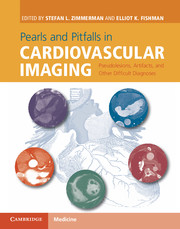 Pearls and Pitfalls in Cardiovascular Imaging
Pearls and Pitfalls in Cardiovascular Imaging from Section 1 - Cardiac pseudotumors and other challenging diagnoses
Published online by Cambridge University Press: 05 June 2015
Imaging description
Cardiac angiosarcoma is an aggressive, infiltrative mass that is most often found in the wall of the right atrium. On CT, they are typically low-attenuation, broad-based lobulated masses with heterogenous enhancement post-contrast (Figure 9.1). On MRI, cardiac angiosarcoma is heterogenous due to presence of intralesional hemorrhage and necrosis; however, it is predominantly T2 hyperintense and T1 isointense to myocardium (Figure 9.2). Flow voids within the mass may be seen due to extensive vascularity. Occasionally, tumors may be avidly enhancing with post-contrast tumor attenuation at CT and MRI nearly identical to the blood pool (Figure 9.1). Tumor infiltration into adjacent structures such as the pericardium, superior or inferior vena cava, or interatrial septum is common (Figure 9.3). Hemorrhagic pericardial effusions are typically seen and can be large.
Importance
Cardiac angiosarcomas may be difficult to diagnose at enhanced chest CT due to their hypervascularity (Figure 9.1). They can appear very similar in attenuation to the blood pool and may be overlooked if close attention is not paid to the heart. Early, small tumors may be also difficult to appreciate on non-gated CT examinations due to motion. The presence of a de novo hemorrhagic pericardial effusion should prompt close inspection of all cardiac chambers for this entity. Accurate diagnosis is critical for proper patient management.
Typical clinical scenario
Cardiac angiosarcomas are rare, although they are the most common primary cardiac malignancy. They represent 10% of all primary cardiac tumors. Patients will most often present with chest pain, tamponade, or right heart failure. The majority of patients will have metastastic disease at usually survive beyond 12 months.
Differential diagnosis
Cardiac metatastases are much more common than primary cardiac angiosarcoma and should always be considered. These will commonly be multiple and will be associated with additional sites of metastastic disease throughout the body. Lung, melanoma, and breast cancer are common tumors to metastasize to the heart.
To save this book to your Kindle, first ensure [email protected] is added to your Approved Personal Document E-mail List under your Personal Document Settings on the Manage Your Content and Devices page of your Amazon account. Then enter the ‘name’ part of your Kindle email address below. Find out more about saving to your Kindle.
Note you can select to save to either the @free.kindle.com or @kindle.com variations. ‘@free.kindle.com’ emails are free but can only be saved to your device when it is connected to wi-fi. ‘@kindle.com’ emails can be delivered even when you are not connected to wi-fi, but note that service fees apply.
Find out more about the Kindle Personal Document Service.
To save content items to your account, please confirm that you agree to abide by our usage policies. If this is the first time you use this feature, you will be asked to authorise Cambridge Core to connect with your account. Find out more about saving content to Dropbox.
To save content items to your account, please confirm that you agree to abide by our usage policies. If this is the first time you use this feature, you will be asked to authorise Cambridge Core to connect with your account. Find out more about saving content to Google Drive.